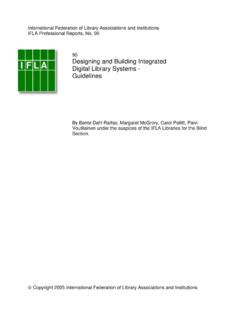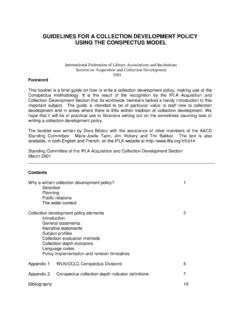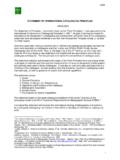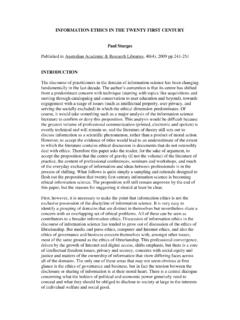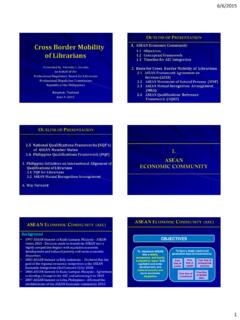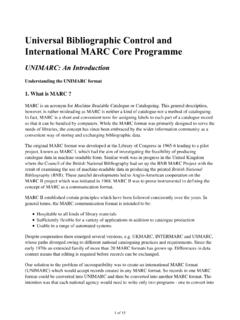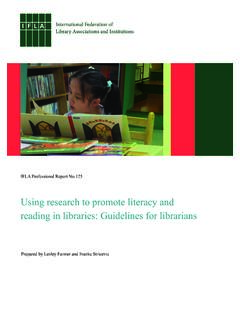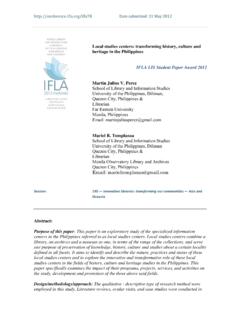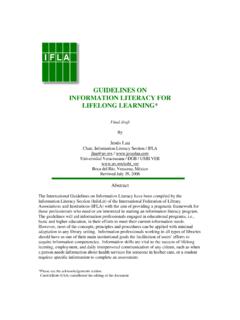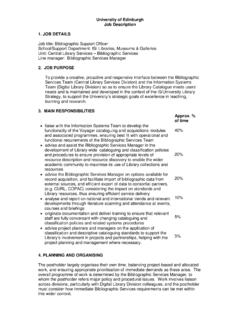Transcription of Alignment of the ISBD: International Standard ...
1 Alignment of ISBD with RDA, 1 August 2014. Version3 (draft). Alignment of the ISBD: International Standard bibliographic Description element set with RDA: Resource Description & Access element set Gordon Dunsire and IFLA Cataloguing Section's ISBD Review Group Version , 17 February 2015 Introduction This is the Alignment of the consolidated edition of the ISBD: International Standard bibliographic Description1 element set with RDA: Resource Description & Access2 element set. The aim of the Alignment is to enable harmonization between data produced according to the ISBD or RDA metadata content rules. Harmonization is achieved if the data is functionally interoperable; that is, data from both sources supports the functional requirements of each Standard . Harmonization does not imply that the content is identical, so variation in content should be expected, although not sufficiently different to have a significant effect.
2 The joint meeting of the ISBD Review Group and ISSN Network with the Joint Steering Committee for Development of RDA (JSC) held in Glasgow, 2011, defined functional interoperability as that by which records valid under one of the standards should be capable of being mapped to either of the other standards . It is recognised that some issues will take longer to resolve than others and a few issues may prove to be irreconcilable, but steps can be taken to limit the impact of such differences. The Alignment task is defined in Outcomes3, Action 24. Mappings: JSC and ISBD agreed to set up a task group to look at Appendix D mappings between RDA and ISBD and between ISBD and RDA elements . The ISBD element set is published in the consolidated edition of the ISBD (pp. 14717), while the definitions in the table for ISBD elements are taken from the OMR.
3 These definitions have been approved by the ISBD Review Group, and derive from the ISBD Glossary and the ISBD text. The scope notes of ISBD elements in the OMR have been taken into account in the Alignment , but are excluded here for brevity. The RDA element set and definitions are taken from the RDA Toolkit, which is synchronized with the OMR. 1 ISBD : International Standard bibliographic Description / recommended by the ISBD Review Group ; approved by the Standing Committee of the IFLA Cataloguing Section. Consolidated ed. Berlin ; Boston, Mass. : De Gruyter Saur, 2011. 2 RDA : Resource Description & Access / developed in a collaborative process led by the Joint Steering Committee for Dvelopment of RDA (JSC) . Chicago : American Library Association ; Ottawa : Canadian Library Association ; London : CILIP: Chartered Institute of Library and Information Professionals, 2010.
4 3 Alignment of ISBD with RDA, 1 August 2014. Version3 (draft). The alignments include relationship designators taken from RDA Appendix J. Information used to determine the alignments is taken, in order of priority, from: 1. Definitions 2. Scope notes 3. Other text in the documentation 4. Examples in the documentation The alignments ignore: The assignment of FRBR Group 1 entities to the RDA elements . Differences in the sources of information for each element, as given in the documentation, except where they significantly affect the meaning or semantic of the element rather than just the content of specific instances. The Alignment shows that: There are elements lacking in one or the other content Standard . The definitions of elements with the same label can be broader or the same irrespective of the Standard .
5 The alignments given are not formal or operational mappings from ISBD elements to RDA elements . Instead, they are intended to support a variety of maps for different applications. For example, a specific application may choose to treat the three categories of Alignment (broader, narrower, equal) as a single mapping type (approximately equal, or equivalent, etc.). One such application is a map for the RDF (Resource Description Framework) representations of the ISBD element set4 and RDA element set5 in the Open Metadata Registry6 (OMR:), using the methodology discussed in the briefing/discussion paper7 tabled for the Glasgow meeting by Gordon Dunsire. The methodology uses the RDF Schema property subPropertyOf for narrower and broader alignments between so7called unconstrained properties, that is, properties that do not have a defined RDF domain or range.
6 4 5 6 7 Alignment of ISBD with RDA, 1 August 2014. Version3 (draft). Version Version of the Alignment includes changes in the RDA element set up to and including the February 2015 release of the RDA Toolkit. The RDF representation of the RDA element set was published in January 2014, with new URIs and a parallel set of unconstrained elements . A parallel set of unconstrained ISBD elements with the same URI local part (with a different base domain) and the same definition but with no RDFS domain will be published in due course. Alignment of ISBD with RDA, 1 August 2014. Version3 (draft). Alignment of ISBD element set with RDA element set Note: The direction of this Alignment is from ISBD to RDA only. An Alignment from RDA to ISBD will be developed separately.
7 Alignment indicators < ISBD element is narrower in definition and scope than RDA element > ISBD element is broader in definition and scope than RDA element = ISBD element is the same in definition and scope as RDA element Sources ISBD definition Taken from the ISBD element set vocabulary in the OMR. It refers to a resource. ISBD number Taken from the ISBD consolidated edition 2011 RDA definition Taken from the RDA Registry in the OMR. RDA number Taken from the RDA Toolkit. Table columns ISBD Element Label of the ISBD element ISBD Number of the ISBD element A Alignment RDA Element Label of the RDA element RDA Number of the RDA element I URI URI local part of the unconstrained ISBD element I Definition Definition of the unconstrained ISBD element U URI URI local part of the unconstrained RDA element U Definition Definition of the unconstrained RDA element Notes Notes Alignment of ISBD with RDA, 1 August 2014.
8 Version3 (draft). ISBD Element ISBD A RDA Element RDA I URI I Definition U URI U Definition Notes Content form < Content Type P1001 A category that reflects the fundamental form or forms in which the content is expressed. P60049 A categorization reflecting the fundamental form of communication in which the content is expressed and the human sense through which it is intended to be perceived. 7 Content qualification < Content Type P1002 A sub7category that expands a category that reflects the fundamental form or forms in which the content is expressed. P60049 A categorization reflecting the fundamental form of communication in which the content is expressed and the human sense through which it is intended to be perceived. Media type = Media Type P1003 A category that records the type or types of carrier used to convey the content.
9 P60050 A categorization reflecting the general type of intermediation device required to view, play, run, etc., the content of a resource. Title = Title P1012 A word or phrase, or a group of characters, usually appearing on the resource, that is the name of the resource or the work (or any one of a group of individual works) contained in it. P60369 A word, character, or group of words and/or characters that names a resource or a resource contained in it. 7 Title proper < Title Proper P1004 The title proper (the chief name of a resource, the title of a resource in the form in which it appears on the preferred source of information for the resource). P60515 The chief name of a resource ( , the title normally used when citing the resource). Due to ISBD component titles of individual works.
10 77 Common title (of title proper) < Title Proper P1137 That part of the title that is carried by a group of related resources in addition to their different section titles. P60515 The chief name of a resource ( , the title normally used when citing the resource). ISBD: Component of ISBD aggregated statement. < Title P1137 That part of the title that is carried by a group of related resources in addition to their different section titles. P60369 A word, character, or group of words and/or characters that names a resource or a resource contained in it. ISBD: Component of ISBD aggregated statement. Alignment of ISBD with RDA, 1 August 2014. Version3 (draft). 77 Dependent title (of title proper) < Title Proper P1138 A title that by itself is insufficient to identify the resource and that requires the addition of the common title, or the title of the main resource or the title of the main series.
